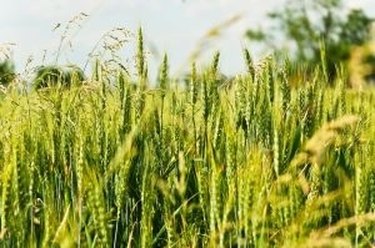
Wheat Kernels
Wheat grows from wheat kernels, which are also known as wheatberries. The kernel is composed of an endosperm, the bran and the germ. From the endosperm we get white flour, while the endosperm plus bran gives us whole wheat flour. Bran and germ can be purchased individually. Kernels are planted at different types of the year depending on what kind of wheat is to be grown.
Classes
Video of the Day
There are thousands of varieties of wheat. All of them fall into one of six classes: durum, hard and soft white wheat, hard and soft red winter wheat, and hard red spring wheat. As you might guess, the winter varieties are planted so that they are exposed to cold winter temperatures, which helps their development, while the spring varieties are planted in the spring. The winter wheat varieties are planted in the fall around the time of the first freeze for an early summer harvest. The spring varieties are harvested in the late summer or fall. The stages of growth are roughly the same for all types of wheat.
Video of the Day
Germination Leading to Leaf Production
Germination begins after a kernel is planted. Roots grow and the coleoptile emerges. A coleoptile is a sheath that protects the new shoot that will grow. Once the coleoptile breaks through the soil, a new leaf emerges through the tip of the coleoptile. After that, a new leaf is formed every four or five days until the plant has eight leaves (nine for varieties that mature later). The last leaf is called the flag leaf.
Tillering
Tillering refers to wheat plants growing shoots. How many the plant grows depends on its variety and growing conditions. Three is a normal number. These shoots are in addition to the main shoot from which leaves emerged. A fully developed tiller ends up producing grain, but not all tillers will get that far. Tillers that grow at the same time that the fourth through the sixth leaves appear have the best chance of producing grain. Meanwhile, tiny heads form on the tillers and the main shoot. Under favorable conditions, here is where the flower structures and kernels will be formed. When the head is fully formed, the stem begins to grow longer.
Head Growth, Emergence and Flowering
Elongation of the stems and quick head growth go hand in hand. The individual wheat florets prepare for pollination and fertilization. Up until now, the developing head has been enclosed in a sheath. Now it emerges and a few days later, pollination begins. The pollination of the florets in a head takes about four days.
Kernel Growth and Maturity
Pollination means seeds--in the case of wheat, kernels. The kernels grow over the course of about a month. Maturity is easy to see because the head changes color from green to amber.